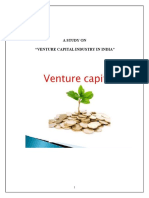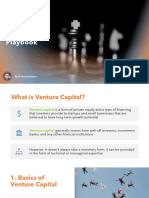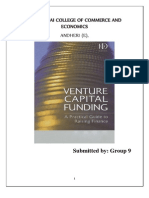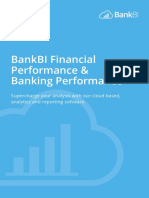Introduction To Venture Capital
Uploaded by
ana luizaIntroduction To Venture Capital
Uploaded by
ana luizaVenture Capital (VC)
Venture Capital (VC) is where the magic happens in the startup world. It's a place where big ideas
meet big money, and where today's startups become tomorrow's giants. In this guide, we're diving
into the heart of VC, a field that's all about fueling innovation and turning bold visions into reality.
It's where risk meets reward, and where investors don't just put in their money, they put in their faith
in what the future could be.
Here's what we're unpacking in this guide:
1. Venture Capital 101: Get the lowdown on what venture capital really is, why it's a
game-changer for startups, and how it's different from just having deep pockets.
2. Who's Who in VC: Discover the different roles in a VC firm. From the big-shot partners to
the eagle-eyed analysts, learn what they do and how they fit into the VC puzzle.
3. Show Me the Money: We're talking salaries, bonuses, and all the perks of working in VC.
Find out what you can expect to earn, whether you're just starting out or you're running the
show.
4. Climbing the VC Ladder: What does it take to move up in the world of venture capital?
We're breaking down the career paths and how to navigate them.
5. Skills and Smarts: What do you need to know to make it in VC? We're covering the
must-have skills, the educational background, and those extra certifications that can give you
an edge.
6. Breaking into VC: For the newbies, students, and grads, here's how you can get your foot in
the door of the VC world. We're talking internships, networking, and the courses that count.
7. Life After VC: What happens after you've made your mark in venture capital? Explore the
paths you can take once you've got VC experience under your belt.
Whether you're dreaming of a career in VC, you're a student plotting your path, or you're just
curious about this high-stakes, high-reward world, this guide is your insider's look into the exciting,
ever-evolving landscape of venture capital. Let's dive in!
I. VC an overview:
a) Understanding Venture Capital
Venture capital represents a specialized segment of private equity, primarily aimed at investing in
startups and early-stage enterprises with significant growth prospects. This form of financing is
MIM Prep Education 1
distinct from traditional funding avenues, catering specifically to innovative ventures with high risk,
often without access to standard financial channels due to their early development stage or inherent
riskiness. In exchange for capital, venture capitalists acquire an equity stake in these companies, tying
their financial returns to the company's growth and profitability.
b) Venture Capital's Impact on Startups
The role of venture capital in the startup ecosystem is multifaceted. It extends beyond mere financial
support to include providing industry knowledge, mentorship, and valuable networking
opportunities, all crucial for the accelerated growth and expansion of startups. VC firms take an
active role in steering their portfolio companies, utilizing their extensive experience and connections
to boost startup success. This investment approach not only fosters innovation and job creation but
also drives technological progress and economic expansion.
c) Motivations for Obtaining Venture Capital
Businesses often pursue venture capital for diverse reasons, such as to expand their operations or to
fund the development of new products and services. Due to the substantial financial requirements of
starting and growing a business, many companies backed by venture capital may not turn a profit for
an extended period. Capital Investment
Venture capital involves investing in private equity, distinct from public market investments like
those on the New York Stock Exchange. These investments are usually made through limited
partnership agreements, allowing both individual and institutional investors to engage in various
venture capital endeavors while maintaining limited liability. Venture capital funds frequently focus
on specific industry sectors, creating portfolios of companies within these domains.
e) The Structure of Venture Capital Firms
Typically, a venture capital fund is set up as a partnership, with the venture capital firm and its key
members serving as general partners, and the investors as limited partners.
1. General Partners: These individuals are actively involved in managing, advising, or serving
on the boards of the invested companies. They are integral to the strategic and operational
decisions of the fund.
2. Limited Partners: These investors contribute capital but do not engage in the fund's daily
management or decision-making.
3. Distribution of Profits: The profit-sharing arrangement usually grants general partners a
20% performance-based incentive (carried interest) and up to a 2% annual management fee.
The rest, about 80% of the profits, is allocated to the limited partners.
MIM Prep Education 2
Differences from Other Forms of Funding:
Venture capital differs from other funding modalities, such as bank loans, angel investment, or
public markets, in several key ways. Venture capital investments involve higher risk but offer the
potential for significant returns if successful. VC investors typically receive equity in the company,
allowing them to share in the success and growth of the business. Moreover, venture capitalists
generally have a longer investment horizon, willing to wait several years for a startup to mature
before seeking an exit.
Historical Context and The Evolution of Venture
Capital:
The origins of modern venture capital trace back to the mid-20th century, notably gaining
momentum in the United States post-World War II. Initially focused on funding startups in
technology and innovation-driven industries, several key milestones shaped the evolution of venture
capital.
Post-War Era:
Following World War II, venture capital emerged as a means to fund innovation and technological
advancements, particularly in electronics and aerospace.
Silicon Valley:
The development of Silicon Valley in California became a hotspot for venture capital activity,
especially in the 1960s and 1970s, supporting the growth of semiconductor and computer
technology companies.
Regulatory Changes:
MIM Prep Education 3
Regulatory changes, such as the Small Business Investment Act of 1958 in the U.S., encouraged
venture capital growth by providing incentives for private investment in small businesses.
Dot-com Boom and Beyond:
The late 1990s witnessed the dot-com boom, characterized by substantial investment in
internet-based startups, leading to a market correction but also paving the way for the emergence of
new industries and technologies.
Roles: Analyst to Advisor
Over time, venture capital has evolved into a global phenomenon, expanding beyond technology to
encompass various sectors such as biotechnology, healthcare, clean energy, and more. The industry
adapts to market dynamics, technological advancements, and changing investor preferences, playing
a vital role in shaping the modern business landscape.
In the operational landscape of a venture capital (VC) firm, the orchestration of various roles
assumes paramount significance, collectively contributing to the effective functioning of the firm
and the implementation of discerning investment strategies. This delineation encompasses a
comprehensive elucidation of the typical roles intrinsic to a VC firm, delineating the attendant
responsibilities and expectations integral to each position.
Analysts / Investment Analysts:
Analysts, positioned as entry-level contributors, play an instrumental role in collaborating with the
investment team. Their purview includes the meticulous gathering of data, execution of financial
modeling, and undertaking exhaustive research on industries and market trends. Their pivotal role
extends to the evaluation of the financial health and growth potential of target companies. This
entry-level role serves as a foundational platform for individuals with robust analytical acumen and a
background in finance, allowing them to actively support the due diligence process, contribute
substantially to investment recommendations, and participate in the ongoing monitoring of portfolio
companies.
Associates / Investment Associates:
Associates, assuming a subsequent tier in the hierarchy, provide integral support to the investment
team. Their responsibilities encompass comprehensive market research, due diligence, and financial
analysis concerning potential investment opportunities. Associates actively participate in deal
MIM Prep Education 4
sourcing, assess pitch decks, and prepare investment memos for presentation to the investment
committee. Drawing upon a combination of analytical proficiency and industry knowledge,
associates play a vital role in identifying promising startups, evaluating market trends, and assessing
the viability of potential investments. Their remit may further extend to supporting portfolio
company management and offering post-investment assistance.
Partners / Managing Partners:
Partners, positioned as senior leaders within a VC firm, wield substantial influence in setting
investment strategy, rendering key investment decisions, and overseeing the overarching operations
of the firm. Leveraging extensive industry experience, networks, and expertise, partners play a
pivotal role in sourcing potential investment opportunities, negotiating deals, and providing strategic
guidance to portfolio companies. Additionally, they assume a critical role in fundraising
endeavors and maintaining relationships with limited partners (LPs) or investors in the VC fund.
Venture Partners / Advisors:
Venture Partners or Advisors, although potentially not full-time employees, contribute to the firm
based on specific domain expertise or industry connections. These individuals bring specialized
knowledge, expansive networks, and hands-on experience in a particular industry or technology
sector. Operating on a part-time or advisory basis, they actively participate in deal sourcing, provide
valuable insights, and facilitate introductions to potential investment opportunities.
Operations / Support Roles:
The operational echelons of a VC firm are fortified by roles encompassing administrative, legal,
marketing, and operational support. Professionals in these capacities oversee day-to-day operations,
ensure legal compliance, manage fund administration, orchestrate marketing efforts, and engage in
investor relations. Their comprehensive responsibilities ensure the seamless functioning of the firm's
operations and extend supportive functions to the investment team through administrative tasks.
While the delineation of expectations and responsibilities is standard across VC firms, nuances may
exist based on factors such as size, focus areas, investment strategies, and developmental stage. A
confluence of collaborative ethos, robust analytical skills, industry knowledge, networking
proficiency, and a fervor for entrepreneurship is universally esteemed across all roles within a VC
firm. As individuals accrue experience and showcase efficacy, progression to more senior positions
with heightened responsibilities and decision-making authority becomes a tangible prospect.
MIM Prep Education 5
Pros of Working in VC
The professional terrain of a venture capital firm is characterized by a constellation of perks and
benefits, transcending the confines of standard salary packages. These ancillary offerings are
strategically designed to attract top-tier talent, engender employee retention, and foster an
environment conducive to nurturing innovative thinking and facilitating successful investments.
Equity Stakes/Carried Interest:
Foremost among the perks within VC firms is the prospect for employees, particularly partners and
senior professionals, to acquire equity stakes or carried interest in the fund's prosperous investments.
Carried interest affords employees the opportunity to partake in the profits generated by successful
exits, furnishing a substantial financial incentive intricately tied to the fund's performance.
Flexible Work Hours and Remote Work:
Many VC firms adopt a flexible approach to work hours, empowering employees to manage their
schedules judiciously. Furthermore, provisions for remote work are often in place, endowing
employees with the flexibility to work from home or other locations as exigencies dictate. This
flexibility is particularly advantageous for professionals seeking to balance work commitments with
personal responsibilities.
Networking Opportunities:
Extensive networking opportunities constitute a hallmark of VC firms, providing employees with
avenues to interact with entrepreneurs, industry leaders, fellow investors, and experts spanning
diverse sectors. Access to an expansive network proves invaluable for deal sourcing, gaining insights,
and cultivating relationships conducive to enhancing the firm's portfolio.
Learning and Development:
Many VC firms prioritize a culture of continuous learning and professional development.
Venture capital presents various advantages for professionals, investors, and entrepreneurs due to its
dynamic nature and focus on supporting innovative startups. Key advantages include:
MIM Prep Education 6
1. Exposure to Innovative Ideas:
VC professionals gain exposure to cutting-edge technologies, disruptive business models, and
innovative ideas, fostering exploration and investment in groundbreaking solutions across diverse
industries.
2. Potential for High Returns:
VC investments carry the potential for substantial returns, with successful investments in
high-growth startups generating significant profits that often surpass traditional investment vehicles.
3. Supporting Entrepreneurship and Innovation:
VC funding fuels entrepreneurship by providing capital, mentorship, and resources, enabling the
transformation of innovative ideas into viable businesses that drive economic growth and job
creation.
4. Networking Opportunities:
Involvement in VC offers extensive networking opportunities, facilitating interactions with
entrepreneurs, industry experts, investors, and corporate partners, leading to collaborations and
future investment opportunities.
5. Access to Diverse Investment Opportunities:
VC firms have access to a diverse range of investment opportunities, allowing investors to spread
risk across multiple startups in various stages of development and industries.
6. Learning and Exposure to Different Industries:
Working in VC exposes professionals to various industries and markets, providing a rich learning
experience and valuable insights into different sectors, business models, and market trends.
7. Contributing to Impactful Innovation:
MIM Prep Education 7
VC investments often support startups addressing global challenges, contributing to advancements
in healthcare, clean energy, sustainability, and technology, creating positive impacts on a larger scale.
8. Dynamic and Challenging Work Environment:
The fast-paced and dynamic nature of VC provides professionals with challenges and opportunities
for continuous learning, adaptation, and strategic decision-making, creating an intellectually
stimulating and rewarding environment.
In summary, VC offers a blend of financial opportunities, exposure to cutting-edge innovations,
networking advantages, and the satisfaction of supporting transformative startups, making it an
appealing and exciting field for investors and professionals alike.
Cons of Working in VC
While VC presents numerous opportunities, it also comes with several challenges that professionals
often encounter:
1. High-Pressure Environment:
The pressure to identify promising startups, make successful investment decisions, and achieve
profitable exits creates a high-pressure work environment, fostering stress and intense competition.
2. Deal Uncertainties and Risk:
Venture capital involves investing in early-stage companies with uncertain futures, introducing high
risks and the potential for some startups to fail despite initial promise.
3. Long Hours and Demanding Workloads:
VC professionals often work long hours due to demanding deal sourcing, due diligence,
negotiations, and portfolio management activities, requiring dedication beyond standard working
hours.
4. Deal Execution Complexity:
MIM Prep Education 8
Negotiating investment terms, structuring deals, and navigating legal complexities can be intricate
and time-consuming, demanding thorough analysis and attention to detail.
Salaries & Compensation:
Remuneration in venture capital is subject to wide-ranging differentials predicated on factors such as
firm size, geographical location, individual experience, and performance metrics. A comprehensive
overview of salary ranges across varying roles and seniority levels within a VC firm elucidates the
following:
Entry-Level Positions (Analysts / Associates):
- Analysts: Entry-level analysts in VC firms command salaries ranging from $60,000 to $100,000 per
annum, contingent on location and firm dimensions. The spectrum is notably influenced by regional
cost-of-living considerations.
- Associates: Associates, assuming a tier above analysts, typically garner higher salaries ranging
between $80,000 and $150,000 annually. The variance is contingent on factors such as firm prestige,
location, and the associate's antecedent experience.
Mid-Level Positions (Senior Associates / Principal-level roles):
- Senior Associates: With a cumulative tenure, senior associates command salaries spanning from
$120,000 to $200,000 per annum. This bracket is subject to augmentation based on performance
metrics and the assumption of additional responsibilities.
- Principal or Vice President (VP) Level: Remuneration for these mid-level roles spans a spectrum of
$150,000 to $300,000 or more annually. This tier typically encompasses a performance-based bonus
or carry, affording employees the opportunity to partake in the profits realized from successful
investments.
Senior Management (Partners / Managing Partners):
- Partners: The compensation structure for senior partners or managing partners is notably variable.
Total compensation can significantly surpass base salaries due to carried interest or performance
bonuses linked to fund success. Salaries for partners exhibit a wide range, extending from $200,000
to several million dollars annually, contingent upon firm performance, carried interest, and the scale
and success of investments.
MIM Prep Education 9
Venture Partners / Advisors:
Compensation for Venture Partners or Advisors may not consistently align with fixed salaries,
potentially incorporating advisory fees, a segment of carried interest, or other performance-based
incentives. The remuneration framework for these roles exhibits variability, often contingent on
individual contributions and the stipulations of their engagement with the firm.
Beyond base salaries, the compensation landscape in venture capital is further enriched by bonuses
or performance-based incentives, such as carried interest or profit-sharing arising from successful
investments. Carried interest, representing a percentage of profits generated by the fund's
investments, emerges as a pivotal component significantly amplifying overall compensation for
senior professionals within successful VC firms.
Moreover, compensation in venture capital extends beyond pecuniary considerations, encompassing
additional perks such as healthcare benefits, retirement contributions, access to networking
opportunities, and the prospect for career progression as individuals accumulate experience and
cultivate a track record of successful investments on behalf of the firm.
Career Progression in Venture Capital
The career trajectory within a venture capital (VC) firm is characterized by a systematic progression
through various roles and levels of seniority. Although the specific path may vary among firms based
on factors such as size, structure, and investment focus, a generalized overview of a typical career
progression within a VC firm can be delineated.
Entry-Level Roles (Analyst / Associate)
Analyst:
At the onset of one's career in a VC firm, individuals often assume the role of an Analyst. These
entry-level positions primarily involve providing support to the investment team by conducting
market research, performing financial analysis, and executing due diligence on potential investment
opportunities. Analysts contribute to deal sourcing activities, prepare investment memos, and assist
in managing portfolio company relationships.
Associate:
As professionals gain experience or transition from an Analyst role, they may progress to the
position of Associate. Associates undertake more substantial responsibilities in deal evaluation, due
MIM Prep Education 10
diligence processes, and engagement with entrepreneurs. They play a more active role in the
investment decision-making process, contributing significantly to the overall investment strategy.
Mid-Level Roles (Senior Associate / Principal)
Senior Associate:
After accruing a few years of experience, individuals may advance to Senior Associate roles. In these
positions, they assume leadership responsibilities, leading deal evaluations, managing junior team
members, and actively participating in deal sourcing and negotiation activities.
Principal:
Principals, typically more senior members of the investment team, bring significant experience to the
table. They actively lead deal sourcing efforts, take a leading role in negotiating and structuring
investments, and often have decision-making authority. Principals play a crucial role in shaping the
firm's investment strategy.
Senior Management (Partners / Directors/ Managing Partners)
Partner / Managing Partner:
Partners, serving as senior leaders within the firm, are entrusted with setting the investment strategy,
making key investment decisions, and overseeing the overall operations of the firm. They contribute
industry expertise, extensive networks, and play pivotal roles in fundraising, deal sourcing, and
guiding portfolio companies.
Director / Managing Director:
Some firms may designate director-level positions, often just below the partner level. Individuals in
these roles contribute to investment decisions, lead deal execution, and might oversee specific
sectors or areas within the firm.
Venture Partners / Advisors:
These roles are typically filled by industry experts or successful entrepreneurs who bring specialized
domain knowledge or networks to the firm. While not necessarily full-time positions, Venture
MIM Prep Education 11
Partners or Advisors collaborate with the firm on a part-time or advisory basis, contributing insights
to deal sourcing, evaluation, or portfolio management.
C-Suite / Leadership Roles
Transition to Leadership Positions:
In certain instances, professionals may transition to leadership positions within portfolio companies
or assume executive roles, leveraging their VC experience to lead startups or scale-up ventures.
The progression within venture capital is inherently meritocratic, contingent upon an individual's
performance, networking acumen, ability to source successful deals, and contributions to the overall
success of the firm's investment portfolio. As individuals accumulate experience, develop industry
expertise, and demonstrate a track record of successful investments, they may ascend to more senior
positions within the firm or even embark on entrepreneurial ventures by establishing their own VC
firms.
Titles and Responsibilities
Analyst / Associate:
Analysts, occupying entry-level positions, are responsible for conducting market research, financial
analysis, and due diligence. Associates, with more experience, engage in deal sourcing, pitch
evaluation, and negotiations, supporting investment proposals and monitoring portfolio company
performance.
Senior Associate / Principal:
Senior associates lead deal evaluations, manage junior team members, and contribute to shaping the
firm's investment strategy. Principals, as senior members, lead deal sourcing, negotiation, and
contribute significantly to the firm's investment decisions.
Partner / Managing Partner:
Partners, as senior leaders, set the investment strategy, make key decisions, and manage overall
operations. Directors, often just below partners, lead deal execution and contribute to the firm's
investment strategy.
MIM Prep Education 12
Venture Partner / Advisor:
Venture Partners or Advisors bring industry expertise or networks on a part-time or advisory basis,
contributing insights and guidance.
Director / Managing Director:
Directors led deal execution, oversee specific sectors, and contribute to the firm's investment
strategy. Individuals may transition to leadership positions within portfolio companies.
The responsibilities associated with these titles can vary based on the firm's size, structure, and
investment focus. Nevertheless, as individuals progress through these roles, they assume more
leadership, decision-making, and strategic responsibilities, contributing to the identification,
evaluation, and management of investment opportunities in the venture capital landscape.
REQUIRED QUALIFICATIONS
Venture capital (VC) roles necessitate a multifaceted amalgamation of educational background,
specialized skills, and industry knowledge. While a rigid formula is non-existent, specific educational
backgrounds, skills, and certifications can confer advantages upon individuals aspiring to pursue
careers in VC. This discourse provides an elaborate examination of these facets, encompassing
educational backgrounds, requisite skills, and certifications.
Educational Background
1. Business / Finance / Economics:
A degree in business administration, finance, economics, or related fields establishes a foundational
understanding of financial analysis, valuation, and investment principles. Courses encompassing
accounting, corporate finance, and investment analysis contribute significantly.
2. Technical Degrees (Engineering, Sciences):
MIM Prep Education 13
Degrees in engineering, computer science, life sciences, or other technical fields prove invaluable,
particularly when assessing startups in technology-driven sectors like biotech, AI, or clean energy.
Technical knowledge is instrumental in comprehending product feasibility and market potential.
3. MBA or Advanced Degrees:
Pursuing an MBA or advanced degrees, such as a Master's in Finance or Entrepreneurship, offers a
broader business perspective, strategic thinking, and networking opportunities crucial for VC roles.
Skills
1. Financial Analysis and Modeling:
Proficiency in financial analysis, valuation techniques, and constructing financial models is
imperative. Analytical skills facilitate the evaluation of startups' financial health, growth projections,
and investment potential.
2. Market Research and Due Diligence:
The ability to conduct thorough market research, assess industry trends, and perform due diligence
on startups is crucial for evaluating market fit, competitive landscape, and scalability.
3. Communication and Networking:
Strong communication skills are indispensable for presenting investment proposals, negotiating
deals, and building relationships with entrepreneurs, co-investors, and industry stakeholders.
4. Entrepreneurial Mindset:
Possessing an entrepreneurial mindset, creativity, adaptability, and the ability to take calculated risks
are paramount for understanding and supporting startup ventures.
5. Strategic Thinking and Decision-Making:
Critical thinking, strategic decision-making, and the ability to identify promising investment
opportunities aligning with the firm's investment thesis are highly valued skills.
MIM Prep Education 14
6. Leadership and Teamwork:
Collaborative skills to work effectively in teams, lead projects, and mentor junior team members are
advantageous in VC roles.
Certifications and Additional Qualifications
1. Chartered Financial Analyst (CFA):
The CFA designation provides a strong foundation in investment analysis, portfolio management,
and ethics, proving beneficial for roles involving investment decision-making in VC.
2. Financial Modeling and Valuation Certifications:
Certifications in financial modeling, valuation, or specific industry sectors can enhance skills relevant
to VC roles.
3. Entrepreneurial Programs and Bootcamps:
Participation in entrepreneurial programs, accelerators, or bootcamps focused on startup evaluation,
entrepreneurship, and innovation offers practical insights into the startup ecosystem.
While these educational backgrounds, skills, and certifications are valuable, the VC industry places
significant emphasis on practical experience, networking, and a demonstrated ability to source,
evaluate, and manage successful investments. Combining educational qualifications with relevant
industry experience, internships, and a passion for startups can significantly enhance one's prospects
in the competitive VC field.
How to Break Into VC
Breaking into the venture capital world as a student or recent grad means you've got to be strategic,
proactive, and ready to hustle. Here's a down-to-earth guide on how to get your foot in the door:
1. Hit the Books and Sharpen Your Skills
MIM Prep Education 15
● Education Matters: Dive into courses related to finance, business, economics, or tech.
Thinking about an MBA or specialized courses in entrepreneurship or finance? Go for it!
● Skill Up: Get savvy with financial analysis, market research, and Excel. There are tons of
online courses and workshops out there to boost these skills.
● Internship Hustle: Look for internships at VC firms, startup accelerators, or companies
with venture backing. Even roles in business development or market research at startups can
give you a sneak peek into the VC world.
2. Network Like a Pro
● Hit Up Events: Get yourself to VC events, conferences, and seminars. Chat up speakers,
panelists, and other attendees.
● Join the Club: If your school has clubs focused on entrepreneurship or VC, join them!
Participate in discussions and workshops.
● Social Media Savvy: Use LinkedIn and Twitter to connect with industry folks. Join in on
discussions and share your thoughts on the latest trends.
3. Keep Your Finger on the Pulse
● Stay Informed: Follow VC blogs, podcasts, and publications. Know what's hot, what's not,
and who's who.
● Try Your Own Thing: Ever thought about starting your own project or joining a startup?
It's a great way to show you've got skin in the game.
4. Build Relationships and Find Mentors
● Talk to the Pros: Don't be shy to reach out to VC pros for a chat. Ask for advice and learn
from their journeys.
● Keep At It: Follow up after events, keep in touch, and show you're serious about breaking
into VC.
5. Use Your School's Resources
● Alumni Networks: Your school's alumni can be a goldmine. Connect with those in VC for
insider advice.
● Career Services: Don't forget about your school's career resources. They can offer great
insights and connections.
Remember, getting into VC is all about being proactive, constantly learning, and not being afraid to
put yourself out there. By building the right skills, gaining real-world experience, networking smartly,
MIM Prep Education 16
and staying on top of industry trends, you're setting yourself up for a shot at the exciting world of
venture capital.
Exit Opportunities
After you've spent some time in the venture capital scene, a whole world of career options can open
up. It's like having a backstage pass to the show of business innovation. Here's a look at some paths
you might wander down after cutting your teeth in VC:
Switching to Startup Life
● Be Your Own Boss or Join a Startup Team: Loads of folks in VC end up jumping into the
startup pool – either by starting their own thing or joining someone else's early-stage
adventure. All that VC experience? It's gold for understanding the ins and outs of what
makes a startup tick.
Exploring Bigger Ponds in Finance
● Private Equity (PE) Beckons: If you're thinking bigger, private equity firms could be your
next playground. Here, you're looking at larger deals, later-stage investments, or even big
buyouts. And guess what? All that financial savvy you picked up in VC is super handy here.
● Investment Banking or Corporate Development: Maybe the high-stakes, high-energy
world of investment banking calls to you, or you're eyeing a role in corporate development.
Both paths value the analytical chops and deal-making skills honed in venture capital.
Remember, your time in VC isn't just about the deals you make; it's about the skills you build, the
people you meet, and the insights you gather. All of this can be your ticket to an exciting next
chapter, whether that's launching your own startup, diving into the deep end of private equity, or
steering big financial decisions in investment banking or corporate development. The VC world is
just the beginning – where you go next is up to you!
20 Technical Interview Questions & Answers
Q1: What elements should a candidate emphasize in responses during VC interviews, both
technical and non-technical?
MIM Prep Education 17
A1: Ideal responses in VC interviews necessitate a combination of expertise, critical thinking,
analytical skills, adaptability, clear communication, and a strategic approach to investment
decision-making. Candidates should provide specific examples, showcase industry knowledge, and
align responses with the firm's investment objectives and philosophies.
Q2: What is the purpose of technical interview questions in VC interviews?
A2: Technical interview questions are designed to assess candidates' knowledge, analytical abilities,
and understanding of financial concepts essential in the field of Venture Capital. Preparation and
familiarity with these topics can significantly enhance performance during VC interviews.
Q3: How does a DCF analysis estimate the present value of a company?
A3: A DCF analysis estimates the present value of a company by forecasting its future cash flows
and discounting them back to their present value using a discount rate, often the weighted average
cost of capital (WACC). It involves projecting free cash flows, calculating terminal value, and
discounting those values back to their present worth.
Q4: What are pre-money valuation and post-money valuation in the context of startup
funding rounds?
A4: Pre-money valuation refers to a company's value before additional funding is raised in a round,
while post-money valuation includes the value of the company after the new investment has been
added.
Q5: How is terminal value calculated in a DCF analysis?
A5: Terminal value is typically calculated using the perpetuity growth method or exit multiple
method. Perpetuity growth assumes cash flows grow at a constant rate indefinitely, while the exit
multiple method uses a comparable company's multiple applied to the final year's cash flow.
Q6: What is the importance of a cap table in a startup's financing structure?
A6: A cap table lists the company's securities, ownership stakes, and details of shareholders,
including founders, employees, and investors. It's crucial for tracking ownership, equity dilution, and
determining share prices during financing rounds.
MIM Prep Education 18
Q7: How does dilution impact the ownership stakes of founders and investors during
subsequent funding rounds?
A7: Dilution occurs when new shares are issued, reducing existing shareholders' ownership
percentages. During subsequent funding rounds, dilution affects both founders and early investors
by reducing their ownership stakes.
Q8: What are the key factors considered in due diligence on a potential investment
opportunity?
A8: Key factors include market analysis, team evaluation, product viability, competitive landscape,
financials, legal/compliance checks, and potential risks.
Q9: Can you outline the steps involved in performing market sizing for a startup's product
or service?
A9: Steps may include identifying target customer segments, estimating market penetration,
calculating market share, and evaluating the total addressable market (TAM), serviceable addressable
market (SAM), and the share of market (SOM).
Q10: Discuss the significance of the term sheet and its key components in a venture capital
deal negotiation.
A10: A term sheet outlines the basic terms and conditions of a potential investment. Key
components include valuation, investment amount, governance rights, liquidation preferences, and
anti-dilution provisions.
Q11: How would you assess a startup's unit economics and why is it crucial in evaluating its
sustainability?
A11: Unit economics involves analyzing costs and revenues at a per-unit level. It helps assess the
profitability of a company at each transaction and is crucial for evaluating its long-term sustainability.
Q12: Explain the different valuation methodologies used in Venture Capital, such as
comparable company analysis and precedent transactions.
MIM Prep Education 19
A12: Comparable company analysis compares the target company with similar public companies to
determine its value, while precedent transactions use the valuation multiples from recent acquisitions
of similar companies to assess the target company's worth.
Q13: Walk me through the steps you'd take to evaluate a startup's competitive landscape.
A13: Steps involve identifying direct and indirect competitors, analyzing their strengths and
weaknesses, assessing market positioning, understanding barriers to entry, and evaluating
differentiation strategies.
Q14: What metrics or key performance indicators (KPIs) would you consider when
analyzing a SaaS (Software-as-a-Service) startup?
A14: KPIs for SaaS may include Monthly Recurring Revenue (MRR), Customer Acquisition Cost
(CAC), Churn Rate, Customer Lifetime Value (CLTV), and Gross Margin.
Q15: Can you discuss the impact of a company's burn rate on its runway and overall
financial health?
A15: Burn rate refers to the rate at which a company spends its cash. It affects the company's
runway, which is the time it can operate before running out of funds, and can impact financial health
if not managed properly.
Q16: Explain the concept of liquidation preference and its implications for investors in case
of an exit or liquidation event.
A16: Liquidation preference grants investors the right to receive a specific amount of proceeds
before other shareholders in the event of a liquidation or exit, ensuring they are paid back their
initial investment before others receive distributions.
Q17: Discuss the factors you would consider when estimating the cost of capital (WACC) for
a startup.
A17: Factors include the cost of equity, cost of debt, and the company's capital structure. WACC
represents the average rate of return required by all the company's stakeholders (debt and equity
holders).
MIM Prep Education 20
Q18: What are the main risks associated with early-stage investments, and how would you
mitigate them?
A18: Risks include market risks, technology risks, management risks, and liquidity risks. Mitigation
involves thorough due diligence, diversification, mentorship, and close monitoring of portfolio
companies.
Q19: Can you differentiate between equity financing and debt financing for startups,
highlighting their advantages and disadvantages?
A19: Equity financing involves selling ownership stakes in exchange for capital, while debt financing
involves borrowing money that needs to be repaid with interest. Equity offers ownership flexibility
but dilutes ownership, while debt provides control but requires repayment.
Q20: Describe the process of conducting sensitivity analysis in financial modeling and its
significance.
A20: Sensitivity analysis tests how changes in one variable affect outcomes and is crucial in assessing
the impact of different scenarios on a startup's financial performance, helping in risk assessment and
decision-making.
20 Competency Interview Questions & Answers
Q1: Discuss a recent technological innovation that has captured your attention and elucidate
its potential impact on the market.
A1: Recently, my focus has been on a groundbreaking technological innovation within the social
media realm. During a university project, I evaluated a social media startup, meticulously analyzing
market demand, the competitive landscape, revenue models, and user engagement metrics. The key
considerations encompassed scalability, differentiation, and potential monetization strategies.
Q2: Describe an occasion when you had to evaluate a business idea or project. How did you
approach it, and what were the key factors you considered?
A2: In a team project centered on a tech startup's market entry strategy, my role involved in-depth
analysis of market data and competitor landscapes. Through collaborative brainstorming, task
MIM Prep Education 21
delegation based on expertise, and regular progress meetings, we ensured alignment and successfully
navigated the project's complexities.
Q3: Can you share an experience where you worked in a team to solve a complex problem?
What was your role, and how did the team approach the challenge?
A3: Leading a project, unforeseen technical issues caused delays. I proactively communicated with
stakeholders, reassessed timelines, and reallocated resources. This experience underscored the
importance of adaptability, proactive communication, and contingency planning.
Q4: Tell me about a time when you faced failure or setbacks. How did you handle it, and
what did you learn from the experience?
A5: In a time-sensitive project with limited data, I conducted thorough research, consulted industry
experts, and analyzed existing trends to make well-informed decisions. Regular updates and feedback
loops helped adjust course when necessary
Q5: Discuss a startup or company you admire and explain why it stands out in the industry.
A4: SpaceX is a company I greatly admire for its pioneering work in space exploration and
reusability of rocket technology. Its disruptive approach to the aerospace industry, coupled with
visionary leadership from Elon Musk, sets it apart as an innovative trailblazer.
Q6: Can you talk about a trend or industry shift that you believe will significantly impact the
future of businesses?
A6: The rise of ESG (Environmental, Social, and Governance) investing is transforming business
practices. Companies focusing on sustainability, ethical practices, and social responsibility are gaining
investor attention, impacting long-term business strategies.
Q7: Describe a situation where you had to make a decision with limited information. How
did you ensure your decision was well-informed?
A7: During a presentation to stakeholders with varied backgrounds, I simplified complex technical
concepts into relatable analogies and visual aids. Using plain language and interactive visuals, I
effectively conveyed intricate details, ensuring everyone understood the key points.
MIM Prep Education 22
Q8: Share an example of a time when you had to communicate complex information or
concepts to a non-technical audience.
A8: Leading a fundraising campaign for a charity event was a significant initiative. We exceeded our
target, raising awareness and funds for the cause. I learned invaluable leadership skills, such as team
coordination and effective communication. LE WAGON PRESENTATION
Q9: Discuss a project or initiative you initiated or led. What were the outcomes, and what
did you learn from the experience?
A9: In a brainstorming session, I proposed a new customer engagement strategy that utilized social
media analytics. Implementing this approach significantly increased user interaction and improved
our brand visibility.
Q10: Share an example of a time when you provided innovative ideas or solutions that
positively impacted a project or task.
A10: In a fast-paced startup environment, I faced abrupt changes in project scope. I quickly adapted
by reassessing timelines, reallocating resources, and revising strategies. My ability to pivot and
maintain focus amid uncertainty ensured project success.
Q11: Describe a successful networking experience you had and how it positively impacted
your goals or career aspirations.
A11: Attending a venture capital conference, I networked with industry professionals and exchanged
insights. One connection led to a mentorship opportunity, offering guidance and opening doors to
valuable career advice and opportunities.
Q12: Describe a situation where you showed adaptability in response to changing
circumstances or unexpected challenges.
A12: During a time-sensitive project, I organized tasks, set interim milestones, and maintained open
communication with the team. I remained composed, focused on priorities, and leveraged
time-management techniques to deliver quality results within the deadline.
Q13: Talk about a time when you had to handle a tight deadline or work under pressure.
How did you manage the situation?
MIM Prep Education 23
A13: While developing a new marketing strategy, I took a calculated risk by exploring a less
conventional approach. I conducted thorough risk assessments, analyzed potential outcomes, and
gained buy-in from stakeholders before implementation.
Q14: Describe a situation where you had to take calculated risks or make a decision in the
face of uncertainty. How did you approach it?
A14: I regularly engage with industry-specific publications, attend webinars, and participate in
professional networking events. Subscribing to newsletters and following influential thought leaders
on social media keeps me informed about the latest trends and innovations.
Q15: Can you explain how you stay updated on industry trends, market developments, and
emerging technologies relevant to Venture Capital?
A15: In a diverse team, I adjusted my communication style by using clear and concise language while
ensuring inclusivity. Tailoring my approach to individual preferences facilitated effective
collaboration and mutual understanding among team members.
Q16: Discuss a situation where you had to adapt your communication style to effectively
interact with different stakeholders or team members.
A16: During a group project, conflicting opinions arose regarding project direction. I facilitated
open dialogue, ensuring everyone's viewpoints were heard, and encouraged consensus-building
exercises. A compromise was reached by focusing on common goals and objectives.
Q17: Talk about a time when you encountered conflicts or disagreements within a team
project. How did you resolve them?
A17: During my internship, I handled various projects concurrently. I used a prioritization matrix to
categorize tasks based on urgency and importance. Daily to-do lists and regular check-ins helped me
stay organized and effectively manage deadlines.
Q18: Can you share an experience where you had to manage multiple tasks or projects
simultaneously? How did you prioritize and organize your work?
MIM Prep Education 24
A18: In a market analysis project, I utilized statistical tools to interpret data, identifying key trends
and correlations. This enabled informed decision-making and provided actionable insights crucial
for the project's success.
Q19: Share an example of how you've demonstrated strong analytical skills in evaluating
data or information for a project or problem-solving.
A19: In a diverse team, I adjusted my communication style by using clear and concise language while
ensuring inclusivity. Tailoring my approach to individual preferences facilitated effective
collaboration and mutual understanding among team members.
Q20: Discuss a situation where you had to adapt your communication style to effectively
interact with different stakeholders or team members.
A20: During a group project, I proposed an alternative strategy for market expansion. I prepared a
comprehensive presentation highlighting the benefits and presented compelling data. Open
discussions and addressing concerns resulted in team consensus and successful adoption of the
proposal.
Top 11 Venture Capital Firms
Venture capital is like the secret sauce in the startup world, and each VC firm brings its own unique
flavor to the table. Let's take a stroll through some of the big names and what makes them stand out:
Sequoia Capital: These guys are like the wise owls of the VC world, focusing on early and
growth-stage investments in tech, healthcare, and more. They've backed big names like Apple and
Google and have a cool program called "Sequoia Scout" where entrepreneurs tip them off about hot
new startups.
Andreessen Horowitz (a16z): Tech startups, listen up! a16z is all about software, fintech, and even
crypto. They're not just about writing checks; they roll up their sleeves and help with everything
from operations to marketing. Think Airbnb and Coinbase – they're part of the a16z family.
Accel Partners: These folks have an eye for early and growth-stage tech and consumer internet
companies. Ever heard of Facebook or Slack? That's Accel's handiwork. They're big on partnering
with founders and helping them scale up, especially in Europe and the U.S.
Kleiner Perkins: If you're a tech-driven company in enterprise software or healthcare, Kleiner
Perkins might be your fairy godmother. They've been in the game since the days of Amazon and
Google and love backing ventures with the potential to shake things up.
MIM Prep Education 25
Tiger Global Management: With a focus on global tech, consumer internet, and e-commerce,
Tiger Global doesn't shy away from aggressive investments. They're the ones behind big names like
Stripe and Coinbase and are always on the lookout for the next big thing, especially in emerging
markets.
Index Ventures: These guys have their fingers in many pies, investing in early and growth-stage tech
companies across SaaS, fintech, and more. They've got a strong presence in Europe and the U.S. and
have backed companies like Slack and Revolut.
Battery Ventures: Big on tech, especially software and industrial tech, Battery Ventures is all about
collaborating with entrepreneurs. They've got a global reach and have invested in companies like
Wayfair and Glassdoor.
Greylock Partners: From Facebook to LinkedIn, Greylock Partners knows how to pick winners in
enterprise software, cybersecurity, and consumer internet. They're all about diving in and providing
operational support and industry expertise.
500 Startups: If you're an early-stage startup in tech, e-commerce, or health, 500 Startups might be
your ticket. They're known for their broad investment strategy and global presence, offering
mentorship and network access to help startups grow fast.
Y Combinator: This accelerator is a godsend for early-stage tech startups. They provide seed
funding, mentorship, and a network of connections. Airbnb and Dropbox are some of their success
stories.
Founders Fund: Looking for something out of the box? Founders Fund invests in groundbreaking
tech startups in sectors like biotech and space exploration. They're the brains behind investments in
SpaceX and Palantir Technologies, always on the hunt for disruptive ideas.
So, there you have it – a quick tour of some of the top venture capital firms and their unique
approaches. Whether it's through industry focus, investment stage preference, or hands-on support,
each of these firms plays a crucial role in shaping the success of innovative companies in the startup
ecosystem.
Importance of Commercial Awareness in Venture
Capital
In the fast-paced world of venture capital (VC), having your finger on the pulse of the market – what
we call commercial awareness – is absolutely key. Let's break down why it's such a big deal.
Catching the Next Big Thing
MIM Prep Education 26
● Trendspotting: Keeping up with market trends, industry buzz, and tech breakthroughs is
crucial. It's how VCs spot the next big thing, whether it's a groundbreaking technology or a
business model that's about to shake things up. This is the stuff that high-growth investment
opportunities are made of.
Reading the Market's Mood Swings
● Feeling Market Shifts: It's all about understanding how consumer tastes are changing and
where industries are heading. This insight helps VCs tweak their strategies to focus on areas
ripe for growth or markets that haven't been fully tapped yet.
● Competitive Check-Up: Knowing who's who in the market, what's saturated, and where
there's a unique niche to fill is crucial. It's about understanding both the opportunities and
the hurdles startups might face.
Navigating the Regulatory Maze
● Regulatory Radar: Staying clued up on laws and regulations means VCs can better gauge
how these changes might impact their investments and strategies. It's a big part of risk
assessment and due diligence.
Smart Investing
● Risk Wrangling: With a solid grasp of market trends and industry shifts, VCs can dodge
some of the bigger investment risks. This means smarter decisions and steering clear of
ventures that might not have staying power.
● Guiding Startups: This isn't just about picking winners; it's also about guiding them. VCs
use their market smarts to help their portfolio companies grow and adapt.
Networking and Deal-Making
● Schmoozing for Success: Being in the know isn't just good for cocktail party chat. It opens
doors to network with industry experts and entrepreneurs, leading to juicy insights, hot leads,
and potential collaborations.
● Attracting Top Deals: Savvy VCs attract better deals. Entrepreneurs want backers who get
the market and can offer more than just cash.
Tech-Savvy Investing
● Tech Love: A keen eye on tech advancements means VCs can spot innovative solutions and
emerging markets. It's about embracing change and staying ahead of the curve.
MIM Prep Education 27
● Backing Tech Winners: To really get behind tech-driven startups, VCs need to understand
the latest tech shifts. This helps them judge whether a startup has the potential to scale, fit
the market, and last in the long haul.
In a nutshell, commercial awareness is the bread and butter of successful venture capital. It's about
making informed, strategic investments and nurturing startups in a world that's always changing. For
VCs, staying updated on market trends, industry news, and tech advancements is not just useful – it's
essential.
CV / Résumé Tips for Venture Capital Roles
Highlight Academic Achievements:
If you have limited work experience, highlighting your academic achievements can be especially
important. List relevant coursework or academic projects demonstrating knowledge and skills in
investing, finance, economics, accounting, or related fields.
Emphasize Relevant Work Experience:
Even with limited work experience, highlight any relevant internships or part-time work experience
to demonstrate your interest in venture capital and your ability to work in a professional
environment. Showcase relevant tasks, responsibilities, or accomplishments.
Showcase Transferable Skills:
Highlight transferable skills such as analytical skills, problem-solving skills, communication skills, and
attention to detail, even if you don't have direct experience in venture capital. Demonstrate these
skills through relevant experiences.
Consider Relevant Extracurricular Activities:
Include any relevant extracurricular activities, such as participation in investment clubs or
finance-related competitions, to demonstrate your interest in the field and willingness to go above
and beyond.
MIM Prep Education 28
Keep it Concise and Well-Formatted:
Aim for a concise and well-formatted CV. Use bullet points and clear headings to make it easy to
skim and read. Keep it to one page if possible, ensuring it is error-free and well-presented. A strong
CV can significantly enhance your chances of securing a venture capital interview.
These comprehensive insights provide a detailed understanding of the unique approaches of top VC
firms, the importance of commercial awareness, and essential tips for crafting an impactful CV for
venture capital roles.
Utilizing Powerful Bullet Points in a Venture
Capital CV
Incorporating impactful bullet points that commence with action verbs is a highly effective method
to enhance the impact and engagement of your CV. Consider the following action verbs for initiating
bullet points in a venture capital CV:
- Analyzed:
Demonstrated the ability to analyze financial statements, market trends, and economic indicators to
identify investment opportunities and risks.
- Managed:
Successfully managed portfolios, executed trades, and monitored performance to ensure alignment
with investment objectives and client expectations.
- Developed:
Formulated investment strategies and recommendations based on comprehensive research and
analysis of market trends, economic conditions, and financial statements.
- Collaborated:
Fostered collaboration with team members, clients, and other stakeholders to build relationships,
identify opportunities, and drive results.
- Implemented:
Executed risk management strategies to mitigate risks and protect client portfolios from market
volatility.
- Conducted:
MIM Prep Education 29
Undertook market research, due diligence, and financial analysis to evaluate potential investments
and make informed investment decisions.
- Communicated:
Effectively communicated complex financial concepts and investment recommendations to clients,
colleagues, and stakeholders in a clear and concise manner.
- Optimized:
Optimized financial models through continuous monitoring and analysis, making strategic
adjustments to maximize returns and manage risk.
- Trained:
Trained and mentored junior team members and interns to develop their skills and knowledge of the
venture capital industry.
- Streamlined:
Streamlined investment processes and procedures to increase efficiency, reduce costs, and improve
overall performance.
Remember to tailor your bullet points to the specific job you are applying for and use strong,
action-oriented language to highlight your skills and achievements.
Using Results-Focused Bullet Points:
Crafting results-focused bullet points is an effective strategy for showcasing accomplishments and
demonstrating the impact you had in previous roles. Here are tips for creating results-focused bullet
points:
- Start with an Action Verb:
Initiate each bullet point with a robust action verb that describes the specific task or
accomplishment.
- Quantify Your Results:
MIM Prep Education 30
Utilize numbers to quantify your accomplishments, emphasizing outcomes and benefits such as
increased revenue, cost savings, or improved efficiency.
- Focus on Outcomes:
Emphasize the outcomes and benefits of your accomplishments, highlighting the positive impact on
the organization.
- Tailor to the Job Description:
Align your bullet points with the job description, emphasizing skills and experiences most relevant
to the role.
Examples of results-focused bullet points for an
asset management CV:
- Increased portfolio value by 15% through effective asset allocation strategies.
- Achieved a 95% client retention rate by delivering exceptional customer service and managing
client expectations.
- Streamlined the investment process, reducing transaction times by 25% and saving the firm
$50,000 annually.
- Successfully managed a $10 million portfolio and consistently outperformed industry benchmarks.
- Developed and implemented a risk management plan that reduced portfolio risk by 20% and
increased returns by 10%.
Cover Letter Tips
Research the Company:
Before writing your cover letter, thoroughly research the venture capital firm to which you're
applying. Analyze their website, social media channels, and news articles to understand their values,
goals, and clientele.
MIM Prep Education 31
1. Explain Why You're a Good Fit for the Role:
Use the cover letter to articulate your suitability for the specific role, highlighting relevant experience
and skills.
2. Show Your Enthusiasm:
Demonstrate passion for finance and investing, expressing excitement about the opportunity to
work for the firm. Specify why you are interested in the industry and the particular firm.
3. Keep it Professional:
Maintain professionalism in your cover letter. Avoid using slang or overly casual language. Ensure
the letter is well-structured and easy to read.
4. Why the Company?
Clearly state why you are interested in working for the particular company. Highlight aspects such as
culture, values, mission statement, or ongoing projects that resonate with you.
5. Why the Division?
Explain why you are interested in the specific division or team, emphasizing particular areas of the
venture capital industry or skills that align with the division.
6. Why You?
Detail because you are the right candidate for the role, including relevant education, work
experience, certifications, and qualifications. Provide specific examples aligning with the role's
requirements.
By addressing these three questions - "Why the company?", "Why the division?", and "Why you?" -
in your cover letter, you showcase understanding of the company, highlight your strengths, and
express genuine interest in the position.
MIM Prep Education 32
The Importance of Networking and
Relationship-Building Skills in Venture Capital
In the venture capital world, networking isn't just a buzzword; it's a crucial part of the game. Here's
why rubbing elbows matters:
1. The Deal Hunt: Networking is like a treasure map to finding deals. It opens up a world of
investment opportunities that you might not find through the usual channels.
2. Teaming Up: When you've got a strong network, you're more likely to bump into the perfect
partners – other investors, savvy entrepreneurs, industry gurus – who can help turn a good venture
into a great one.
3. Wisdom Exchange: It's not just about who you know, but what you learn from them.
Networking is a two-way street of sharing industry secrets, trends, and learning from the pros.
4. Trust is a Must: In the VC world, your reputation is everything. Building relationships is key to
establishing trust and credibility. That's what draws in quality deals and sets the stage for successful
investments.
5. Climbing the Ladder: Good networking can put you in the spotlight, leading to all sorts of
career goodies – think promotions, partnerships, and finding mentors who can help you grow.
For anyone in venture capital, being a networking ninja is essential. It's not just about shaking hands
and collecting business cards. It's about opening doors to new investments, sparking collaborations,
learning from the best, and paving your way to professional growth. In short, if you want to thrive in
VC, get out there and connect!
Effective Networking Approaches
Networking in the venture capital world is a bit like being a social butterfly – you've got to
know where to be and how to engage. Here's how you can master the art:
1. Hit Up Industry Events and Conferences: These are your hotspots for rubbing shoulders with
the VC crowd. It's where you get to meet people face-to-face, spark up real conversations, and stay
on top of what's buzzing in the industry.
MIM Prep Education 33
2. Get Clicking on Online Platforms: The digital world is your oyster. Dive into VC-focused
online communities. It's a great way to make new connections, share your two cents, and maybe
stumble upon your next big partnership or investment opportunity.
3. Find Your VC Guru: Look out for seasoned VCs or big names in the industry who can show
you the ropes. Having a mentor is like having a backstage pass – you get access to invaluable insights
and learn from someone who's been there, done that.
4. Join the Club: There are loads of professional groups and associations for VC folks. Joining one
can be your ticket to exclusive networking events, a treasure trove of educational material, and a
sneak peek into industry norms and practices.
5. Mix It Up with Angel Investors: Angel investing networks are like the social mixers of the VC
world. They're a fantastic way to see what deals are floating around, meet up-and-coming
entrepreneurs, and maybe even team up with other investors for a joint venture.
Remember, in venture capital, who you know can be just as important as what you know. So
get out there, shake some hands, join some groups, and start making those connections!
Results-Driven Bullet Points for Venture Capital
CV:
1. Increased portfolio value by 15% through effective asset allocation strategies.
2. Achieved a 95% client retention rate by delivering exceptional customer service and managing
client expectations.
3. Streamlined the investment process, reducing transaction times by 25% and saving the firm
$50,000 annually.
4. Successfully managed a $10 million portfolio and consistently outperformed industry benchmarks.
5. Developed and implemented a risk management plan that reduced portfolio risk by 20% and
increased returns by 10%.
Cover Letter Tips:
1. Explain why you are interested in working for the specific company.
MIM Prep Education 34
2. Elaborate on why you are interested in the particular division or team.
3. Highlight why you are the right candidate for the role, providing specific examples.
The 3 "Why's?" Approach in Cover Letter:
When you're gunning for a role in venture capital, your cover letter needs to pack a punch. That's
where the "3 Why's?" approach comes in handy. It's all about answering three key questions to create
a narrative that's not just compelling but shows you're the perfect fit. Let's break it down:
1. Why This Company?
● The Importance: You gotta show you're not just throwing darts in the dark. Explain why
this particular company caught your eye. It proves you've done your homework and you're
genuinely interested.
● How to Do It: Maybe it's their killer company culture, their values, or a mission statement
that speaks to you. Or perhaps they're working on a project that you find super exciting.
Point it out!
2. Why This Division?
● The Importance: Venture capital's a big world with lots of nooks and crannies. Make it
clear why you're drawn to this specific division or team. It's your chance to show you get the
nuances of the industry.
● How to Do It: Talk about the aspects of venture capital that get you fired up and how they
align with what this team does. If you've got skills or experience that fit like a glove with their
focus, highlight that.
3. Why You?
● The Importance: This is where you shine. Lay out why you're not just a good choice, but
the best choice for this role. Connect your skills, experience, and qualifications directly to
what they need.
● How to Do It: Dive into your relevant education and work history. Got certifications or
special qualifications? Bring them up. And don't just tell them – show them, with real
examples, how you line up with what they're looking for.
Why does this approach rock? Well, for starters, it shows you've really dug into the company and the
role. It personalizes your application, steering clear of the one-size-fits-all trap. It's a great way to
MIM Prep Education 35
highlight how you fit into the bigger picture of what they're doing. Plus, it sets you apart from the
crowd by showing a deeper level of understanding and connection. And let's not forget enthusiasm
– it's infectious, and this approach lets yours shine through.
In short, the "3 Why's?" strategy turns your cover letter into a powerful, tailored narrative that
showcases your research, alignment with the company, and genuine excitement about the
opportunity. It's about making your application more than just a piece of paper – it's your story, why
you belong in that role, at that company, in the venture capital world.
The Clients of VC Firms
Venture Capital (VC) firms are like the conductors of an intricate symphony, orchestrating
interactions with a variety of clients and stakeholders, each playing their own vital part in the startup
world. Let's take a look at the key players typically involved with VC firms:
1. Startups and Early-Stage Companies
● Their Role: These are the bread and butter of VC firms – companies looking for that
crucial funding to grow, develop their products, or break into new markets.
● How They Engage: VCs provide the much-needed cash in exchange for a slice of the
company. But it's more than just money; they also offer strategic advice and priceless
networking opportunities.
2. Entrepreneurs and Founders
● Their Role: These visionaries are on the hunt for funds and strategic partners to bring their
business dreams to life and scale them up.
● How They Engage: It's a two-way street of financial backing and mentorship, with VCs
lending their industry know-how and connections to help navigate the bumpy road of
business growth.
3. Institutional Investors
● Their Role: Think pension funds, endowments, family offices, and corporate venture arms
– they're all about investing in VC funds.
● How They Engage: VC firms gather funds from these big players, offering them a chance
to get in on high-growth opportunities and diversify their portfolios.
4. Limited Partners (LPs)
MIM Prep Education 36
● Their Role: These investors pour money into VC funds, hoping to get a piece of the returns
from successful startup ventures.
● How They Engage: LPs commit their capital with an eye on the potentially lucrative
returns that come from backing winning startups.
5. Co-Investors and Syndicate Partners
● Their Role: Teaming up for bigger funding rounds, these partners join forces with VC
firms.
● How They Engage: By pooling resources, expertise, and additional capital, co-investors
help VCs get in on larger deals that might otherwise be out of reach.
6. Service Providers and Advisors
● Their Role: These are the legal eagles, the number crunchers, and the strategy wizards –
consultants, lawyers, and accounting firms.
● How They Engage: They're essential for the nitty-gritty of due diligence, legalities, financial
advice, and other support services that smooth out the investment process.
Why This Melting Pot Matters
● Diversification: By mingling with a variety of clients, VC firms can spread their bets across
different sectors and stages, strengthening their investment portfolios.
● Ecosystem Building: This collaborative approach helps create a thriving ecosystem that
supports innovation, growth, and networking in the startup community.
● Access to Expertise: Engaging with such a wide range of players gives VC firms access to a
wealth of industry knowledge, market insights, and specialized services – all crucial for
making savvy investment choices and supporting their portfolio companies.
In essence, venture capital firms are at the heart of a dynamic ecosystem, engaging with a diverse
array of stakeholders. Each one brings something unique to the table, contributing to the success of
startups and the vibrancy of the venture capital scene.
Which Sectors Do VCs Invest In?
Venture capital firms are like savvy surfers, always looking for the next big wave in terms of sectors
ripe for investment. They keep their eyes peeled for areas buzzing with innovation, market potential,
and juicy returns. Let's dive into some of the hot sectors they're targeting and what's driving their
interest:
MIM Prep Education 37
1. The Tech World
● What's in It: This is a broad playground that includes everything from software and SaaS to
artificial intelligence and cybersecurity.
● Driving Trends: Right now, there's a lot of excitement around AI, machine learning, and
cloud computing. Plus, emerging tech like quantum computing and blockchain is really
starting to make waves.
2. Healthcare and Biotech
● What's in It: This sector is all about pharmaceuticals, medical devices, digital health,
genomics, and healthcare IT.
● Driving Trends: Telemedicine and digital health are huge right now, along with cutting-edge
biotech innovations and the growing adoption of healthcare IT solutions.
3. Fintech
● What's in It: Here's where finance meets technology – think disruptive payment systems,
lending platforms, blockchain, and insurtech.
● Driving Trends: The fintech world is buzzing with developments in digital payments,
blockchain, cryptocurrencies, insurtech, and wealthtech.
4. Consumer Products and Services
● What's in It: This sector covers a lot, from e-commerce and direct-to-consumer (DTC)
brands to food tech, travel tech, and online marketplaces.
● Driving Trends: E-commerce is evolving rapidly, and there's a growing focus on
sustainability, health-conscious products, and the rise of DTC brands.
5. CleanTech and Sustainability
● What's in It: Think renewable energy, sustainable infrastructure, energy efficiency, waste
management, and solutions for a circular economy.
● Driving Trends: There's a big push for investments in renewable energy sources, circular
economy practices, and sustainable manufacturing methods.
In short, venture capital firms are always on the lookout for sectors where innovation is booming
and the market potential is huge. Whether it's the latest in tech, groundbreaking healthcare
developments, fintech revolutions, consumer trends, or sustainable solutions, these are the areas
getting VCs excited and opening their wallets.
MIM Prep Education 38
Factors Influencing Sector Preferences
Market Trends: Tracking market dynamics, consumer behavior shifts, and emerging trends.
Technological Innovation: Attraction to disruptive technologies or innovations with high growth
potential.
Regulatory Environment: Impact of regulatory changes or supportive policies, especially in sectors
like healthcare and fintech.
Market Size and Potential Returns: Analysis of scalability and market potential for determining
potential returns on investment.
Impact of External Factors: External factors like global events, economic conditions, and societal
shifts influencing VC sector preferences.
VC firms assess sector preferences based on a blend of these factors, aligning investments with their
thesis and anticipating returns.
How Do Venture Capital Firms Generate
Revenue?
Venture capital firms are like savvy surfers, always looking for the next big wave in terms of sectors
ripe for investment. They keep their eyes peeled for areas buzzing with innovation, market potential,
and juicy returns. Let's dive into some of the hot sectors they're targeting and what's driving their
interest:
1. The Tech World
● What's in It: This is a broad playground that includes everything from software and SaaS to
artificial intelligence and cybersecurity.
● Driving Trends: Right now, there's a lot of excitement around AI, machine learning, and
cloud computing. Plus, emerging tech like quantum computing and blockchain is really
starting to make waves.
2. Healthcare and Biotech
MIM Prep Education 39
● What's in It: This sector is all about pharmaceuticals, medical devices, digital health,
genomics, and healthcare IT.
● Driving Trends: Telemedicine and digital health are huge right now, along with cutting-edge
biotech innovations and the growing adoption of healthcare IT solutions.
3. Fintech
● What's in It: Here's where finance meets technology – think disruptive payment systems,
lending platforms, blockchain, and insurtech.
● Driving Trends: The fintech world is buzzing with developments in digital payments,
blockchain, cryptocurrencies, insurtech, and wealthtech.
4. Consumer Products and Services
● What's in It: This sector covers a lot, from e-commerce and direct-to-consumer (DTC)
brands to food tech, travel tech, and online marketplaces.
● Driving Trends: E-commerce is evolving rapidly, and there's a growing focus on
sustainability, health-conscious products, and the rise of DTC brands.
5. CleanTech and Sustainability
● What's in It: Think renewable energy, sustainable infrastructure, energy efficiency, waste
management, and solutions for a circular economy.
● Driving Trends: There's a big push for investments in renewable energy sources, circular
economy practices, and sustainable manufacturing methods.
In short, venture capital firms are always on the lookout for sectors where innovation is booming
and the market potential is huge. Whether it's the latest in tech, groundbreaking healthcare
developments, fintech revolutions, consumer trends, or sustainable solutions, these are the areas
getting VCs excited and opening their wallets.
The Significance and Ramifications of Venture
Capital (VC) Revenue Generation Models
Alignment of Interests
MIM Prep Education 40
The revenue models, particularly the carried interest, serve to align the interests of VC partners and
Limited Partners (LPs). This alignment incentivizes VC firms to actively seek high-performing
investments and support portfolio companies for successful exits.
Risk and Returns
Structured to reward VC firms for identifying and nurturing high-growth startups, the revenue
models ensure profits only after generating substantial returns for LPs. This model acknowledges
and compensates for the inherent risks involved in venture capital investments.
Operational Sustainability
Management fees play a crucial role in covering day-to-day operational expenses. This financial
support enables VC firms to sustain operations, conduct due diligence, provide support to portfolio
companies, and explore new investment opportunities.
Understanding VC firms' revenue models is imperative for LPs, investors, and entrepreneurs seeking
VC funding. It illuminates the mechanisms through which VC firms generate returns, align interests,
and manage their operations, ultimately impacting the overall success and sustainability of the
venture capital ecosystem.
The Importance and Implications of VC Revenue
Generation Models
Application and Selection in VC Accelerator Programs
Startups Apply through a Competitive Selection Process
Startups seeking to join accelerator programs undergo a competitive selection process where they
present their business ideas, team, and growth potential.
Cohort-Based Approach
MIM Prep Education 41
Selected startups become part of a cohort and engage in a structured curriculum involving
workshops, mentoring sessions, networking events, and access to resources.
Mentorship and Guidance
Experienced mentors, industry experts, and successful entrepreneurs offer tailored guidance, advice,
and support to each startup in the cohort.
VC Accelerator Programs are structured initiatives designed to bolster early-stage startups by
providing mentorship, resources, education, and sometimes initial funding over a fixed period,
typically ranging from a few months to a year. These programs aim to accelerate the growth and
development of startups, preparing them for rapid scaling and potential investment.
Access to Resources in VC Accelerator Programs
Structured Support and Benefits
Access to Resources
Accelerators offer startups resources such as workspace, legal and accounting services, access to
investor networks, and sometimes initial funding in exchange for equity (typically a small
percentage).
Demo Day and Investor Introductions
The program often culminates in a "Demo Day" where startups pitch their businesses to a room of
investors, aiming to secure follow-on funding.
Benefits of Accelerator Programs
Mentorship and Guidance
Startups gain access to experienced mentors and advisors who provide invaluable guidance in
refining business models, product development, and market strategies.
Networking Opportunities
MIM Prep Education 42
Exposure to a network of industry professionals, investors, and fellow entrepreneurs helps in
building connections and partnerships.
Resources and Support
Startups gain access to workspace, infrastructure, legal counsel, and other resources that might be
otherwise challenging to acquire at an early stage.
Validation and Credibility
Acceptance into a reputable accelerator program can validate the startup's concept, enhancing
credibility when seeking further investment.
Successful completion of accelerator programs can make startups more attractive to VC firms, as
they have been nurtured and validated through a structured program. VC firms often scout these
programs to identify promising startups with high-growth potential for potential investment
opportunities.
The Different Types of Venture Capital Firms
1. Seed-Stage Venture Capital
Specialized firms that target very early-stage startups or entrepreneurs with innovative ideas, offering
initial funding to get their concepts off the ground.
2. Early-Stage Venture Capital
Firms that primarily focus on investing in startups during their earliest stages, usually in the seed or
Series A funding rounds. They provide initial capital to help with product development, market
entry, and initial growth.
3. Growth-Stage Venture Capital
Firms that invest in more mature startups that have already established their product, achieved
market fit, and are aiming for rapid expansion or scaling up their operations.
4. Corporate Venture Capital (CVC)
MIM Prep Education 43
Venture capital funds established by larger corporations seeking strategic investments in startups.
CVCs provide not just funding but also access to the corporation's resources, networks, and markets.
Angel Investors Vs Venture Capitalists Vs Private
Equity Firms
1. Angel Investors
Typically, affluent individuals who provide capital for startups or early-stage businesses in exchange
for ownership equity or convertible debt. They often invest their personal funds and offer
mentorship or industry expertise to the entrepreneurs they support.
2. Venture Capitalists
Professional investment firms that manage funds from various sources and invest these funds into
startups and emerging companies with high growth potential. VCs usually focus on early-stage,
growth, or expansion-stage businesses, providing capital in exchange for equity and taking an active
role in guiding and scaling these ventures.
3. Private Equity Firms
Firms that manage larger pools of capital raised from institutions and high-net-worth individuals.
Unlike VCs, private equity funds typically invest in more mature companies, aiming to acquire a
controlling stake. They often use strategies like buyouts or restructuring to enhance the value of the
acquired companies before selling or exiting the investment for a profit.
Each investor type differs in the stage of businesses they target, the size of investments, and their
involvement in the companies they invest in. Angel investors generally focus on early-stage startups,
while VCs specialize in startups and high-growth companies. Private equity firms deal with mature
businesses seeking growth or restructuring.
Regional Differences in Venture Capital
MIM Prep Education 44
1. Silicon Valley, USA
Globally renowned for its thriving ecosystem, Silicon Valley attracts significant VC investment due
to a concentration of tech startups, innovation culture, access to talent, and a robust network of
investors and accelerators.
2. New York City, USA
Another prominent hotspot with a diverse array of industries, including finance, media, and tech. It
hosts a strong VC ecosystem and is especially attractive for fintech and media-related startups.
3. London, UK
Known as a leading European hub for fintech and startups, London has a well-established venture
capital scene, benefiting from a diverse talent pool and a favorable regulatory environment.
4. Beijing and Shanghai, China
These cities have witnessed rapid growth in VC investment due to a booming tech industry,
government support, and access to a vast market.
5. Berlin, Germany
Emerging as a major tech hub in Europe, Berlin attracts startups and investment due to its
supportive ecosystem, access to talent, and lower costs compared to other European cities.
Regional variations in venture capital ecosystems are influenced by factors such as government
policies, access to talent, infrastructure, regulatory frameworks, cultural attitudes toward risk, and the
presence of successful startup exits that create a cycle of reinvestment and growth. Each hotspot
offers unique advantages and opportunities for startups and investors alike.
The Stages of Venture Capital Investing
MIM Prep Education 45
1. Pre-Seed / Seed Stage
The initial stage where startups receive funding to develop a concept or prototype. Seed funding
typically supports market research, product development, and initial operations.
2. Series A
Follows the seed stage. Startups at this stage show market validation, often have a working
prototype, and seek funding to scale operations, expand the team, and further develop the product.
3. Series B
Companies at this stage have a solid customer base and seek funds for substantial scaling. Funding
supports increased production, marketing, and further market penetration.
4. Series C and Beyond
Startups at later stages aim to expand globally, acquire competitors, diversify product lines, or
prepare for IPOs. Funding rounds at these stages support substantial growth and market
dominance.
The Investment Decision-Making Process in
Venture Capital
1. Screening and Initial Evaluation
VC firms receive pitch decks or introductions from startups. They conduct initial screenings based
on fit with investment thesis and preliminary assessment of potential.
2. Due Diligence Process
If interested, the VC firm conducts detailed due diligence (research), sometimes involving multiple
meetings, discussions, and deeper analysis.
MIM Prep Education 46
3. Investment Committee Review
After due diligence, the investment team presents findings and recommendations to the investment
committee or partners for final decision-making.
4. Term Sheet and Negotiation
If the decision is positive, the VC presents a term sheet outlining the investment terms, which forms
the basis for negotiation between the VC and the startup.
Negotiation, Term Sheets, and Investment
Agreements in Venture Capital
1. Term Sheet
A non-binding agreement outlining the key terms of the investment, including valuation, funding
amount, ownership stake, governance, liquidation preferences, and rights of investors.
2. Negotiation Phase
Both parties negotiate terms in the term sheet, aiming for a fair agreement that aligns with their
interests.
3. Investment Agreement
Once terms are agreed upon, a legally binding investment agreement is drafted, detailing the terms
outlined in the term sheet, as well as additional legal clauses, representations, and warranties.
4. Closing
After finalizing the investment agreement, both parties sign the documents, funds are transferred,
and the deal is officially closed.
MIM Prep Education 47
The negotiation process, term sheets, and investment agreements form the foundation of the
investment deal, setting the terms and conditions that govern the relationship between the VC firm
and the startup throughout the investment period. It's crucial for both parties to engage in
transparent and comprehensive negotiations to build a mutually beneficial relationship.
Understanding The Financial Statements of
Startups
1. Income Statement (Profit and Loss Statement)
Provides a snapshot of a company's revenues, expenses, and profitability over a specific period. It
includes revenue, cost of goods sold (COGS), gross profit, operating expenses, net income, and
earnings before interest, taxes, depreciation, and amortization (EBITDA).
2. Balance Sheet
Presents a company's financial position at a given point in time. It consists of assets (such as cash,
inventory, property), liabilities (such as debts, payables), and shareholder equity (the difference
between assets and liabilities).
3. Cash Flow Statement
Tracks the cash inflows and outflows from operating, investing, and financing activities. It highlights
a company's ability to generate cash and manage liquidity.
Understanding these financial statements is crucial for investors, allowing them to assess a startup's
financial health and make informed investment decisions.
Valuation Methodologies in Venture Capital
MIM Prep Education 48
Discounted Cash Flow (DCF) Analysis
Estimating the present value of a company involves forecasting its future cash flows and discounting
them to their current value, accounting for the time value of money.
Comparable Company Analysis (CCA or Comps)
Comparing financial metrics of the target company with similar publicly traded entities helps derive a
valuation benchmark, considering parameters like revenue, EBITDA, or multiples such as the
price-to-earnings (P/E) ratio.
Precedent Transactions Analysis
Evaluating a company's value based on recent sale prices of comparable firms in mergers or
acquisitions provides insights into market trends.
Evaluating Financial Health, Growth Potential,
and Scalability
Financial Health Assessment
Analyzing key financial ratios, including liquidity, profitability, and leverage, helps evaluate a
company's solvency, efficiency, and profitability. Examining trends in revenue growth, margins, and
profitability over time is crucial.
Growth Potential Evaluation
Assessing the scalability of the business model involves considering the total addressable market
(TAM), customer acquisition strategies, and potential for revenue diversification.
Scalability Assessment
Evaluating the scalability of operations, technology, and market expansion potential involves
analyzing factors indicating the ability to grow without proportional increases in costs or resources.
MIM Prep Education 49
Risk Evaluation
Identifying and analyzing risks associated with the business model, market dynamics, competition,
regulatory environment, and dependencies on key stakeholders or technology is integral to informed
decision-making.
Additional Considerations
Management Team
Assessing the experience, expertise, and track record of the management team in executing the
business plan and adapting to market changes is essential.
Unique Value Proposition (UVP)
Evaluating the uniqueness and market demand for the product/service offered by the startup,
considering its differentiation from competitors, is crucial.
Exit Strategy
Considering potential exit routes, such as IPO, acquisition, or secondary market sales, and aligning
them with the investor's objectives is a key aspect of the evaluation process.
Evaluating startups involves a comprehensive analysis of financial statements, various valuation
methodologies, and multiple aspects beyond financials to make informed investment decisions in
venture capital. Thorough due diligence, considering both quantitative and qualitative factors, is
essential.
Market Potential Assessment
Market Size and Growth
Evaluating the total addressable market (TAM), assessing its growth rate, and identifying target
market segments are crucial steps in understanding market potential.
MIM Prep Education 50
Market Trends and Dynamics
Analyzing industry trends, emerging technologies, and shifts in consumer behavior helps identify
opportunities and risks in the market.
Customer Needs and Demand
Identifying pain points addressed by the startup, assessing customer feedback, and validating
demand for the product/service offered are integral components of market potential assessment.
Competitive Landscape Analysis
Competitor Identification
Identifying direct and indirect competitors, assessing their strengths, weaknesses, market positioning,
and market share provides insights into the competitive landscape.
Differentiation and UVP
Evaluating how the startup's product or service stands out from competitors and whether it offers a
compelling unique value proposition facilitates understanding of competitive advantages.
Barriers to Entry
Analyzing entry barriers for competitors, such as patents, proprietary technology, network effects, or
high switching costs, helps understand the competitive landscape.
Technological Analysis and Scalability
Technology Assessment
Evaluating the startup's technology stack, innovation, scalability, and potential for disruption within
the industry is critical.
Intellectual Property (IP) Examination
MIM Prep Education 51
Reviewing patents, trademarks, copyrights, and trade secrets ensures their adequate protection and
assesses their importance to the startup's business model.
Scalability and Operations
Analyzing the scalability of the business model, operations, and infrastructure to accommodate
growth without proportional increases in costs or resources is an essential consideration.
Financial, Legal and Operational Due Diligence
Financial Due Diligence
Reviewing financial statements, cash flow projections, revenue models, and historical financial
performance helps understand the company's financial health and projections.
Legal Due Diligence
Examining contracts, agreements, compliance with regulations, litigation risks, and any legal issues
that might affect the company's operations or valuation is crucial.
Operational Due Diligence
Assessing the company's operational efficiency, management team capabilities, organizational
structure, and internal processes is an integral part of due diligence.
Methods Used
Primary Research
Conducting interviews with customers, partners, industry experts, and stakeholders gathers insights
and validates claims made by the startup.
MIM Prep Education 52
Secondary Research
Utilizing publicly available information, industry reports, market research, and academic studies
supplements primary research.
SWOT Analysis
Conducting a comprehensive SWOT (Strengths, Weaknesses, Opportunities, Threats) analysis helps
understand internal and external factors influencing potential success.
Thorough due diligence involves an interdisciplinary approach encompassing market analysis,
competitive assessment, technological evaluation, legal scrutiny, and financial examination. It helps
venture capitalists make well-informed investment decisions and mitigate risks associated with
investing in startups.
Key Performance Indicators for Startups
Customer Acquisition Cost (CAC)
Measuring the cost of acquiring a new customer, including marketing and sales expenses, helps
assess the effectiveness of customer acquisition strategies.
Customer Lifetime Value (LTV)
Estimating the total value, a customer brings throughout their relationship with the company helps
understand the long-term value of customers and guides marketing and retention strategies.
Burn Rate
Indicating the rate at which a company spends its capital over a specific period, the burn rate helps
identify the need for additional funding or efficiency improvements.
Monthly Recurring Revenue (MRR)
MIM Prep Education 53
Representing the predictable and recurring revenue earned monthly from subscriptions or services,
MRR is essential for subscription-based business models.
Churn Rate
Measuring the percentage of customers who stop using a product or service over a given period, the
churn rate impacts revenue and profitability.
Measuring and Tracking Investment Performance
Metrics
Internal Rate of Return (IRR)
Measuring the profitability of an investment, IRR represents the annualized effective compound
growth rate, with higher values indicating more attractive returns.
Multiple on Invested Capital (MOIC)
Indicating how much value an investment has generated compared to its initial cost, MOIC of 3x
means the investment returned three times the initial investment.
Distributions to Paid-In (DPI) Multiple
Evaluating the distributions to limited partners relative to invested capital helps assess how much of
the invested capital has been returned.
Total Value to Paid-In (TVPI) Ratio
Measuring the total value of the investment relative to the capital invested, TVPI accounts for both
the current value of the investment and distributions received.
Post-Investment Analysis
MIM Prep Education 54
Regular Assessment
Regularly assessing and analyzing the performance of portfolio companies against initial projections,
comparing actual outcomes with the initial investment thesis and assumptions is crucial.
Exit Performance
Evaluating the success of investments through exits, such as IPOs or acquisitions, involves assessing
whether returns align with initial expectations.
Portfolio Diversification
Maintaining a diversified portfolio to spread risk across different sectors, stages, and geographies
reduces the impact of underperforming investments.
Active Portfolio Management
Providing support, guidance, and resources to portfolio companies helps them grow and overcome
challenges. Consideration of follow-on investments in promising companies is part of active
portfolio management.
Rebalancing and Reinvestment
Rebalancing the portfolio by divesting underperforming assets and reinvesting in high-potential
opportunities optimizes portfolio performance.
Learning and Adaptation
Continuous learning from successes and failures, refining investment strategies, adapting to market
changes, and improving decision-making processes is crucial.
Managing & Mitigating Portfolio Risk and
Enhancing Portfolio Returns
MIM Prep Education 55
Risk Assessment and Identification
Conducting thorough due diligence to identify and assess risks associated with each potential
investment involves considering market risks, technology risks, competition, regulatory risks, and
management risks.
Portfolio Diversification
Spreading investments across a diverse range of companies, industries, stages, and geographic
regions helps reduce the impact of any single investment's failure.
Active Monitoring and Management
Continuous monitoring of portfolio companies' performance, engaging in active portfolio
management, and providing support and guidance helps mitigate risks and enhance the chances of
success.
Risk Mitigation Strategies
Implementing strategies to mitigate identified risks, such as supporting R&D efforts or diversifying
technological solutions, is an integral part of risk management.
Sector and Industry Diversification
Investing in companies operating in different sectors or industries avoids overexposure to a specific
market segment.
Stage Diversification
Allocating investments across various stages of growth balances risk and return expectations.
Geographical Diversification
Spreading investments across different geographic regions or markets reduces exposure to regional
economic fluctuations or regulatory changes.
MIM Prep Education 56
Portfolio Size and Number of Investments
Opting for a portfolio size and number of investments that allow for effective diversification without
diluting the focus on individual companies is crucial.
Balancing High-Risk, High-Reward Investments with Conservative Options
Risk-Return Tradeoff
Evaluating the risk-return profiles of investments helps balance high-risk, high-reward investments
with more conservative options.
Portfolio Allocation
Allocating a portion of the portfolio to high-risk, high-reward investments with potential for
exponential growth while maintaining a portion for stable, less volatile investments is strategic.
Investment Thesis Alignment
Ensuring investments align with the VC firm's investment thesis and risk appetite recognizes that
some investments may be inherently riskier but offer significant growth potential.
Stress Testing Scenarios
Conducting scenario analysis and stress testing helps understand how the portfolio would perform
under adverse market conditions or if specific investments fail.
Continuous Evaluation and Adaptation
Regularly reassessing and rebalancing the portfolio based on changing market conditions, investment
performance, and risk assessment is necessary. Learning from both successes and failures refines
investment strategies and optimizes risk management.
MIM Prep Education 57
Effectively managing a venture capital portfolio involves ongoing assessment, adaptation, and
strategic decision-making to maximize returns while mitigating risks. Monitoring KPIs and
investment performance metrics helps VC firms make informed decisions and optimize their
portfolio's performance over time.
Assessing Startup Pitches for Investment
Potential
Problem-Solution Fit
Evaluating whether the startup addresses a genuine pain point or problem in the market and offers a
compelling solution is crucial.
Market Opportunity
Assessing the size, growth potential, and market demand for the product or service offered by the
startup involves considering the target market and competitive landscape.
Business Model
Analyzing the revenue model, pricing strategy, customer acquisition plan, and scalability of the
business model is an integral part of assessing a startup's pitch.
Team and Expertise
Evaluating the founding team's capabilities, domain expertise, track record, and ability to execute the
business plan is essential.
Differentiation and Competitive Advantage
Assessing how the startup stands out from competitors and whether it has a unique value
proposition or a defensible competitive advantage is crucial.
Traction and Milestones
MIM Prep Education 58
Considering the startup's traction, key achievements, milestones, user growth, partnerships, and
customer feedback is vital.
Financial Projections
Scrutinizing the realism and credibility of financial projections, understanding assumptions and
growth models presented, is an integral part of evaluating startup pitches.
Structuring Deals with Entrepreneurs
Understanding the Entrepreneur's Needs
Actively listening to the entrepreneur's goals, vision, and expectations, including non-financial
aspects such as mentorship or strategic guidance, is essential.
Term Sheet Preparation
Offering a term sheet outlining proposed investment terms, including valuation, investment amount,
equity stake, governance rights, and other relevant terms is a critical step.
Flexible Negotiation
Negotiating terms collaboratively, aiming for a win-win scenario, and being open to compromise
while ensuring alignment with the VC firm's objectives are essential.
Valuation and Equity Stake
Determining a fair valuation based on industry standards, market trends, and the startup's growth
potential, while balancing it with the equity stake offered, is crucial.
Governance and Control
Discussing governance rights, board representation, decision-making authority, and control
measures to ensure alignment of interests between the VC and the entrepreneur is crucial.
MIM Prep Education 59
Investor Protection
Including provisions for investor protection, such as liquidation preferences, anti-dilution clauses,
and rights during future fundraising rounds, is a necessary consideration.
Exit Strategy and Liquidity
Clarifying and aligning on the expected exit strategy, timelines, and mechanisms for achieving
liquidity for both the VC and the startup is crucial.
Legal and Due Diligence
Involving legal advisors to ensure legal clarity, proper due diligence, and the drafting of investment
agreements and contracts is essential.
Relationship Building
Establishing a collaborative and supportive relationship with the entrepreneur, fostering trust,
communication, and mutual respect for long-term success is key.
Successful deal structuring and negotiation require a balance between meeting the needs of both
parties, creating a fair and favorable agreement, and establishing a foundation for a productive and
mutually beneficial partnership between the venture capitalist and the startup's founders.
Examples of Successful Investments
Facebook (by Accel Partners)
Accel Partners' early-stage investment of $12.7 million in Facebook in 2005 resulted in extraordinary
returns, with the stake valued at over $9 billion after Facebook's IPO.
Instagram (by Benchmark Capital)
MIM Prep Education 60
Benchmark Capital's $500,000 investment in Instagram's seed round in 2010 saw substantial returns
after Instagram's rapid growth and acquisition by Facebook for approximately $1 billion in 2012.
WhatsApp (by Sequoia Capital)
Sequoia Capital's $60 million investment in WhatsApp in 2013 resulted in significant returns as
WhatsApp expanded globally and was acquired by Facebook for $19 billion in 2014.
Stripe (by Sequoia Capital, a16z)
Accel Partners and Andreessen Horowitz's early investments in Stripe's funding rounds contributed
to its valuation at tens of billions of dollars, providing substantial returns for investors.
Slack (by Accel Partners, a16z)
Accel Partners and Andreessen Horowitz's early investments in Slack, revolutionizing workplace
communication and collaboration, resulted in significant returns when the company went public in
2019.
Examples of Unsuccessful Investments
Webvan (by Sequoia Capital)
Sequoia Capital's heavy investment in Webvan, an online grocery delivery startup during the
dot-com boom, resulted in substantial losses as Webvan faced logistical challenges and ultimately
filed for bankruptcy in 2001.
Theranos (by various investors)
Despite substantial funding, Theranos faced regulatory scrutiny and allegations of fraud, leading to
its collapse and significant financial losses for various investors.
Venture Capital Investment Case Studies:
Juicero (by various investors)
MIM Prep Education 61
Juicero attracted investment with the goal of revolutionizing the juicing industry through innovative
technology. No index entries found.Despite considerable financial backing, Juicero faced
technical challenges and shifting market dynamics, ultimately leading to its failure. In 2013, the
company declared bankruptcy, resulting in losses for its investors.
Better Place (by various investors)
Better Place aspired to revolutionize electric vehicles with battery-swapping technology. Despite
substantial investment, Better Place encountered technical challenges and market dynamics that led
to its failure. The company declared bankruptcy in 2013, resulting in losses for its investors.
Quibi (by various investors)
Quibi secured substantial funding for its mobile-focused streaming platform. Despite significant
investment and notable partnerships, Quibi struggled to attract a substantial audience and ceased
operations within a year of its launch. This resulted in losses for its investors.
Conclusion
This guide has aimed to furnish a comprehensive overview of the venture capital industry, including
the various roles within it and the qualifications and skills required for success. We encourage
continuous learning about venture capital, leveraging the available resources to develop skills and
advance careers.
Venture Capital represents an exciting avenue for those passionate about innovation, disruptive
technologies, and entrepreneurial endeavors. The guide has delineated the diverse facets of the VC
industry, offering insights into roles, challenges, and opportunities.
Aspiring professionals in venture capital should recognize the multifaceted nature of the industry,
understanding startup evaluations, financial modeling, deal structuring, and risk management. The
venture into VC demands continuous learning, resilience, and commitment to staying updated with
market trends and emerging technologies.
MIM Prep Education 62
Networking, seeking mentorship, and engaging with industry experts are crucial for gaining insights
and opportunities. While success in VC may have its hurdles, perseverance, adaptability, and a
willingness to learn from both successes and setbacks will pave the way forward.
Venture capital goes beyond financial gains; it champions innovation and drives positive change. By
nurturing a deep passion for transformative ideas and technologies, individuals can forge impactful
careers within this vibrant ecosystem.
Embark on this venture with enthusiasm, commitment, and a relentless pursuit of knowledge. For
those interested in pursuing a career in venture capital, the industry offers a rewarding and
challenging path with numerous opportunities for growth and advancement.
In conclusion, persistence and patience are key for those aspiring to enter the venture capital
industry. Breaking into the field may be challenging, but with hard work, determination, and a
commitment to continuous learning, success is achievable. Networking, staying updated on industry
trends, and seeking professional development opportunities are vital components of this journey.
Good luck!
MIM Prep Education 63
You might also like
- The Venture Capitalist's Playbook - A Comprehensive Guide To Venture Capital InvestingNo ratings yetThe Venture Capitalist's Playbook - A Comprehensive Guide To Venture Capital Investing1 page
- Venture Capital Basics and India InsightsNo ratings yetVenture Capital Basics and India Insights24 pages
- Presentation On Accounts: - Submitted To: Bhavik Sir - Prepared By: - Vipul Gohil (028) - Vishal PatelNo ratings yetPresentation On Accounts: - Submitted To: Bhavik Sir - Prepared By: - Vipul Gohil (028) - Vishal Patel21 pages
- Black Book - Venture Capital Most Important.0% (1)Black Book - Venture Capital Most Important.30 pages
- Chap-20 Entrepreneurial Finance and VentureNo ratings yetChap-20 Entrepreneurial Finance and Venture26 pages
- Shri Chinai College of Commerce and Economics Andheri (E) ,: Submitted By: Group 9No ratings yetShri Chinai College of Commerce and Economics Andheri (E) ,: Submitted By: Group 921 pages
- Venture Capital: Presented By: Chirag Patel Nirav FruitwalaNo ratings yetVenture Capital: Presented By: Chirag Patel Nirav Fruitwala16 pages
- Venture Capital: Samyak Anand Mba B&F A50050220004No ratings yetVenture Capital: Samyak Anand Mba B&F A5005022000416 pages
- CIRCRILC23052014 - Reporting To Central Repository of Information On Large Credits (CRILC)No ratings yetCIRCRILC23052014 - Reporting To Central Repository of Information On Large Credits (CRILC)11 pages
- Peachtree Guide for Accounting StudentsNo ratings yetPeachtree Guide for Accounting Students46 pages
- Advantages and Disadvantages of Incorporation of A CompanyNo ratings yetAdvantages and Disadvantages of Incorporation of A Company3 pages
- Submitted To: Hashem M Khaiyyum (KHM) Lecturer Department of Finance and Accounting School of Business North South UniversityNo ratings yetSubmitted To: Hashem M Khaiyyum (KHM) Lecturer Department of Finance and Accounting School of Business North South University5 pages
- Problem Set 4 - Capital Structure and Cost of CapitalNo ratings yetProblem Set 4 - Capital Structure and Cost of Capital7 pages
- (Compare Us) Reverse Piercing of The Corporate Veil - A Straightforward Path To Justice by Nicholas AllenNo ratings yet(Compare Us) Reverse Piercing of The Corporate Veil - A Straightforward Path To Justice by Nicholas Allen16 pages
- Long Quiz Week 12 Joint Arrangements - ACTG341 Advanced Financial Accounting and Reporting 1No ratings yetLong Quiz Week 12 Joint Arrangements - ACTG341 Advanced Financial Accounting and Reporting 14 pages




















































































